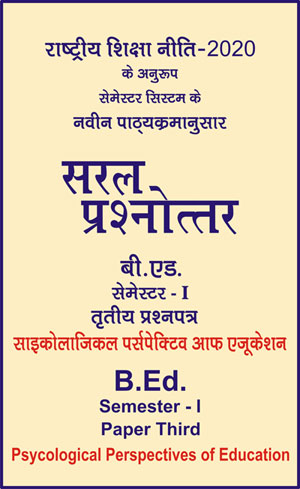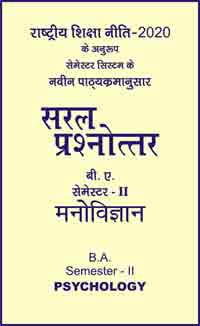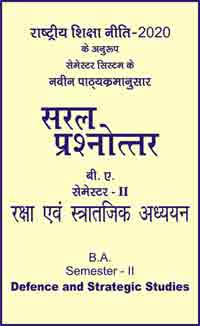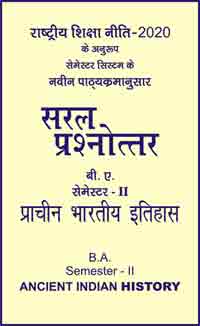|
बी एड - एम एड >> बी.एड. सेमेस्टर-1 प्रश्नपत्र-III - साइकोलाजिकल पर्सपेक्टिव आफ एजूकेशन बी.एड. सेमेस्टर-1 प्रश्नपत्र-III - साइकोलाजिकल पर्सपेक्टिव आफ एजूकेशनसरल प्रश्नोत्तर समूह
|
5 पाठक हैं |
|||||||
बी.एड. सेमेस्टर-1 प्रश्नपत्र-III - साइकोलाजिकल पर्सपेक्टिव आफ एजूकेशन (अंग्रेजी भाषा में)
Infancy, Childhood and Adolescence
1. According to Balte’s lifespan perspective, what is true about development?
(a) Early childhood is the most important part of lifespan development
(b) Development consists of only one dimension or domain
(c) Development is only influenced by nature and not nurture
(d) Development is plastic
2. Which of the following do not reflect continuous change?
(a) Development is cumulative
(b) There are qualitative differences across stages
(c) Changes are quantitative in nature
(d) Development is gradual
3. The fact that people can use later experiences to compensate for earlier deficits is a contradiction of which element of earlier developmental psychology?
(a) Stability
(b) Discontinuity
(c) Continuity
(d) Critical periods
4. Aarjav says that language development is influenced by one’s innate predisposition while Sonali feels that it is because of the environment. This discussion between Aarjav and Sonali is about :
(a) Critical and Sensitive feeling
(b) Stability and Instability argument
(c) Continuous and Discontinuous learning
(d) Nature and Nurture debate
5. Erik Erikson proposed that each stage of development involves a crisis. Human development is :
(a) quantitative
(b) qualitative
(c) both quantitative and qualitative
(d) unmeasurable to a certain extent
6. Which of these scientific techniques for the study of children's development did G. Stanley Hall introduce?
(a) questionnaires
(b) filmed observations
(c) home visits
(d) intelligence tests
7. Which of these scientific techniques for the study of children's development did Arnold Gessel introduce?
(a) the one-way mirror
(b) the questionnaire
(c) observations in the home
(d) clinical interviews
8. What does the phenomenon of observational learning show?
(a) children learn even when they are not receiving reinforcement from the environment
(b) observing a model is a form of reinforcement
(c) a model can condition children's behavior
(d) Televised violence is bad for children
9. When development is viewed as a process that is like 'sculpting a piece of clay', what is equivalent to the clay, and what is equivalent to the shaping?
(a) the child's behavior; the environment
(b) the environment; the child's behavior
(c) the child's mind; evolution
(d) the child's behavior; evolution
10. When did the lifespan approach first emerge?
(a) 1900-1910
(b) 1960-1970
(c) 1940-1950
(d) 1890-1900
11. Which of the following points reflect discontinuous change?
(a) Each new skill builds on earlier ones
(b) Development is gradual and cumulative
(c) Development occurs in distinct, abrupt stages
(d) Knowledge is gradually acquired and built upon
12. Which type of learning can't behaviorism explain?
(a) Operant conditioning
(b) Social learning
(c) Associational learning
(d) Repeated behavior based on reinforcement
13. How do traditional perspectives view the individual?
(a) As passive
(b) As active
(c) Receptive and controlling
(d) None of these
14. In a progressive classroom setup, the teacher facilitates learning by providing an environment that:
(a) is restrictive
(b) promotes discovery
(c) discourages inclusion
(d) encourages repetition
15. A child's notebook shows errors in writing like reverse images, mirror imaging, etc. Such a child is showing signs of:
(a) Learning disadvantage
(b) Learning disability
(c) Learning difficulty
(d) Learning problem
16. Teachers, in order to help learners construct knowledge, need to focus on:
(a) making sure the learner memorizes everything
(b) scores marks obtained by the learner
(c) involving the learner for active participation
(d) mastering learning of concepts by the learner
17. Learning experiences should be planned in a manner so as to make learning meaningful. Which of the given learning experiences does not facilitate meaningful learning for the children?
(a) Repetition based on mere recall of content
(b) Formulating questions on content
(c) Discussion and debate on the topic
(d) Presentation on the topic
18. Who has given the ‘functional theory’ of social stratification?
(a) T. B. Bottomore
(b) K. Davis
(c) Karl Marx
(d) W.E. Moore
19. According to Freudian understanding, thoughts or motives that a person is currently aware of or is remembering is called as:
(a) Conscious
(b) Memory
(c) Sub-conscious
(d) Fixation
20. Change or stability in mental activities such as learning, attention, memory, language, thinking, reasoning and creativity is:
(a) Physical development
(b) Psychological development
(c) Cognitive development
(d) Social construction
21. "Degree of consciousness about thinking, feelings and actions" is:
(a) Self-awareness
(b) Self-esteem
(c) Self-respect
(d) Self-confidence
22. ............ propounds that childhood experiences influence the adult behavior.
(a) Person centered theory
(b) Psychoanalytical theory
(c) Behavior modification theory
(d) Existential theory
23. Maslow in his triangle of human needs showed that:
(a) Challenging new tasks is the basic human need
(b) Money always motivates workers
(c) Safety and security is a low order human need
(d) Workers will not give their best unless they have good social events provided
24. Psychoanalytic theory about human personality was proposed by:
(a) Carl Jung
(b) Skinner
(c) Sigmund Freud
(d) Alfred Adler
25. Behavioral changes which occur on the basis of physiological developments rather than learning and which appear in virtually all members of species are the result of:
(a) Socialization
(b) Rationalization
(c) Maturation
(d) Fermentation
26. To trace the course of mental growth in an individual or the race is the problem of:
(a) Analytical psychology
(b) Synthetic psychology
(c) Genetic psychology
(d) Physiological psychology
27. There is an evidence of a hereditary component in development of the mental illness known as:
(a) Paranoia
(b) Psychoneurotic disorders
(c) Schizophrenia
(d) Paralysis
28. Maturation changes occur in a fairly predictable sequence and continue until:
(a) Adolescence
(b) Adulthood
(c) Old age
(d) None of these
29. A child is born with some:
(a) Qualities
(b) Ego
(c) Innate drives
(d) All of these
30. The child becomes socialized:
(a) Fast
(b) Gradually
(c) Slowly
(d) After ego
31. What is the determinant of the scope of socialization of a child?
(a) Environment
(b) Excitement
(c) Development of physique
(d) Language development
32. Individual differences are found in:
(a) Environmental situations
(b) Cognitive situations
(c) Perceptual situations
(d) Emotional situations
33. What is the result of emotional immaturity in the child?
(a) Struggle
(b) Pain
(c) Frustration
(d) Anger
34. What is the impact of other members of the family besides the parents, on the socialization of the child?
(a) External
(b) Intimate
(c) Good
(d) None of these
35. How do brothers and sisters affect the socialization of the child?
(a) Continuously
(b) Indirectly
(c) Greatly
(d) Commonly
36. What does the youngest child receive all from the parents?
(a) Drives
(b) Attention
(c) All requirements
(d) Affection
37. Applied aspects of social psychology include the development and perfection of techniques for measuring:
(a) Attitude
(b) Opinion
(c) Socialization
(d) Both (a) and (b)
38. The educational psychologist advises a school board on:
(a) Old curriculum
(b) Circulation of stimulus
(c) Knack
(d) New curriculum
38. In the school, the child faces:
(a) Struggle
(b) New society
(c) Group
(d) Resistance
|
|||||














